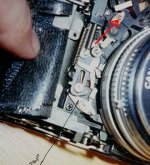Spyderman
Well-known
This is not a question, but a report of successful repair.
Since I bought my Canonet, the Auto mode was a bit off compared to the meter readout. The diaphragm would stop down more than what was shown in the viewfinder (e.g. in VF it would show f2 but the actual aperture on lens was f4).
To understand how to repair it, I first had to understand how it works. It's a so called "trap needle" method. The diaphragm stops down by amount depending on the position of the needle.
And this was off on my camera.
After removeing the top plate there is a finy brass screw on the front of a linkage that governs the diaphragm stopping action. A really tiny movement of the screw solved my problem with auto mode!
I hope this helps those with similar problem...
PS: to check if your camera is good: take a picture on auto (and remember what was the viewfinder meter value). Then turn the camera over and watch the diaphragm blades while turning the aperture ring. When the blades start to move - look at the aperture scale (that is the value to which it was actually stopped-down during the exposure).
Since I bought my Canonet, the Auto mode was a bit off compared to the meter readout. The diaphragm would stop down more than what was shown in the viewfinder (e.g. in VF it would show f2 but the actual aperture on lens was f4).
To understand how to repair it, I first had to understand how it works. It's a so called "trap needle" method. The diaphragm stops down by amount depending on the position of the needle.
And this was off on my camera.
After removeing the top plate there is a finy brass screw on the front of a linkage that governs the diaphragm stopping action. A really tiny movement of the screw solved my problem with auto mode!
I hope this helps those with similar problem...
PS: to check if your camera is good: take a picture on auto (and remember what was the viewfinder meter value). Then turn the camera over and watch the diaphragm blades while turning the aperture ring. When the blades start to move - look at the aperture scale (that is the value to which it was actually stopped-down during the exposure).
Rey
Well-known
Thanks, great info. where, exactly is the screw located?
Share:

